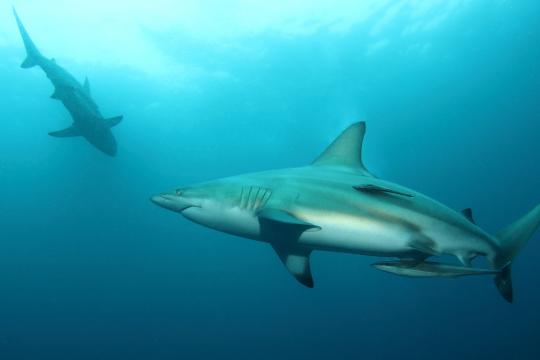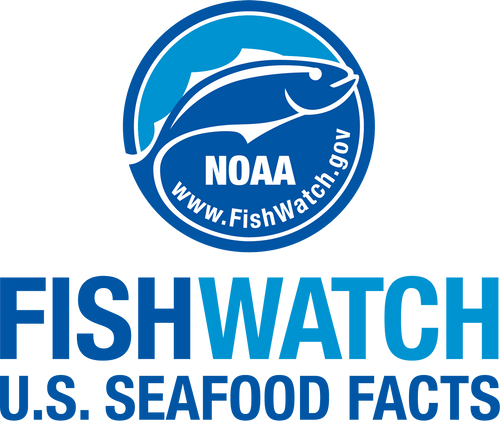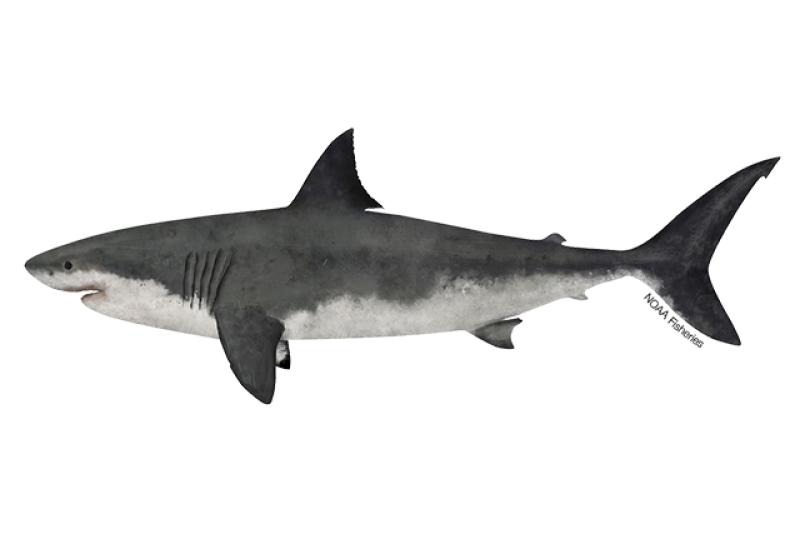 Common thresher shark. Credit: NOAA Fisheries/Walter Heim
Common thresher shark. Credit: NOAA Fisheries/Walter Heim
Common thresher shark. Credit: NOAA Fisheries/Walter Heim
About the Species
 Common thresher shark. Credit: NOAA Fisheries/Walter Heim
Common thresher shark. Credit: NOAA Fisheries/Walter Heim
Common thresher shark. Credit: NOAA Fisheries/Walter Heim
U.S. wild-caught Atlantic common thresher shark is a smart seafood choice because it is sustainably managed and responsibly harvested under U.S. regulations.

Population
The population level is unknown, but management measures are in place.

Fishing Rate
Overfishing status is unknown, but management measures are in place.

Habitat Impact
Gear used to harvest Atlantic common thresher shark does not contact the ocean floor and has no impact on habitat.

Bycatch
Bycatch is low because Atlantic common thresher sharks are primarily incidental catch in other fisheries.
Population Status
- The Atlantic common thresher shark has never been assessed and the overfished status and overfishing status are unknown.
- The International Commission for the Conservation of Atlantic Tunas conducted an ecological risk assessment for pelagic sharks caught in Atlantic pelagic longline fisheries and ranked thresher sharks as the least vulnerable to these fisheries and more productive than the other species included in the risk assessment.
Appearance
- Thresher sharks are brown, gray, blue-gray, or blackish on the back and underside of their snout.
- They are lighter on the sides, and fully white below.
- Their pectoral, pelvic, and dorsal fins are blackish, and there are sometimes white dots on the tips of the pectoral, pelvic, and tail fins.
- Their tail fin is sickle-shaped, and the upper part is extremely long, about half the length of their body.
Biology
- Common thresher sharks live a long time (19 to 50 years), reproduce late in life, and have only a few young at a time.
- They grow slowly, but can reach up to 20 feet long.
- Males sexually mature when they’re 8 to 11 feet long and 3 to 6 years old. Females are able to reproduce when they’re 8 to 9 feet long and 4 to 5 years of age.
- Common thresher sharks mate in late summer. Eggs are fertilized internally and develop within the mother. Females bear live, fully developed young after a long gestation period (9 months), and only have a few pups.
- Common thresher sharks are aggressive predators that feed near the top of the food chain on schooling fish such as herring and mackerel and occasionally on squid and seabirds.
- They are named for their long, scythe-like tail, which is used to stun fish before preying on them.
- Adult common thresher sharks have few predators, but younger, smaller ones may fall prey to larger sharks.
Where They Live
Range
- Common thresher sharks are found in temperate waters around the world.
- In the northwest Atlantic Ocean, they range from Newfoundland to Cuba.
Habitat
- Common thresher sharks are highly migratory species, often traveling over entire ocean basins.
- They’re most common near land and are often found in areas rich with plankton, where their prey is also abundant.
Fishery Management
- NOAA Fisheries and the Atlantic Highly Migratory Species Division manage the Atlantic common thresher shark fishery in the United States.
- Managed under the Consolidated Atlantic Highly Migratory Species Fishery Management Plan:
- Permits are required, and only a limited number of permits are available.
- Commercial quotas and limits on how many sharks can be landed per fishing trip.
- Gear restrictions and requirements.
- Fishing season is generally year-round, but individual commercial shark fisheries close when the quota is reached.
- Shark dealers are required to attend Atlantic shark identification workshops to help them better identify shark species.
- Prohibited species—there are more than 20 species of sharks that cannot be landed (e.g., white, dusky, basking, longfin mako, night). Some of these species look similar to the species that can be landed. The recreational shark identification and the prohibited shark identification placards can help with identification.
- The Shark Conservation Act requires that all sharks, with one exception, be brought to shore with their fins naturally attached.
- Compliance guides are available for all commercial and recreational regulations across Atlantic highly migratory species fisheries.
- Highly migratory species, such as thresher sharks, have complicated management that requires international cooperation.
- A shark that is off the coast of Florida one week could be caught off the coast of Mexico the next. These resources must be managed both in the United States and at the international level.
- The United States negotiates with Regional Fisheries Management Organizations—including the International Commission for the Conservation of Atlantic Tunas, the Food and Agriculture Organization of the United Nations, and the Convention on International Trade in Endangered Species of Wild Fauna and Flora to enhance shark management worldwide.
Harvest
- In 2022, commercial landings of Atlantic common thresher shark totaled 51,000 pounds and were valued at $40,000, according to the NOAA Fisheries commercial fishing landings database.
- To commercially harvest Atlantic sharks, vessel owners must obtain a valid Atlantic shark directed or incidental limited access permit or a smoothhound shark open access permit. More information regarding limited access permits can be found in the Atlantic HMS fishery compliance guides.
- Most of this catch comes from New Jersey and North Carolina.
- Common thresher sharks are part of the pelagic shark complex.
- Gear types, habitat impacts, and bycatch:
- Atlantic common thresher sharks are primarily caught incidentally in longline fisheries targeting swordfish and tuna.
- Gear used to catch common thresher sharks does not impact habitat since it does not contact the ocean floor.
- Fishermen are required to use circle hooks on pelagic longlines to reduce bycatch of sea turtles. All pelagic longline fishing vessels must also carry safe handling and release gear to help in returning any unintentionally caught protected species to the sea safely.
- Fishermen using longline or gillnet gear must complete a protected species safe handling, release, and identification workshop.
- Certain areas are closed to fishing to protect nursery areas, sensitive habitats, and populations.
- Vessel monitoring systems ensure fishermen are complying with area closures.
- Recreational fishermen fish for common thresher sharks, mainly with rod-and-reel gear.
- Recreational fishermen must have an Atlantic HMS permit to harvest Atlantic common thresher sharks in federal waters. As of January 1, 2018, all HMS recreational permit holders will need a “shark endorsement” to fish for, retain, possess, or land sharks.
- In 2022, recreational anglers landed 3 million pounds of common thresher shark, according to the NOAA Fisheries recreational fishing landings database.
- In addition to the shark endorsement, fishermen fishing recreationally for sharks will be required to use circle hook in most places. Circle hooks are less likely to be caught in the thresher shark’s long tail, increasing the survival of sharks that are caught and released. For more information regarding these requirements, please refer to HMS regulations and the Amendment 5b compliance guide.
- Sharks must be a minimum size to be caught, and there is a limit on how many sharks can be caught per fishing trip.
Scientific Classification
- Common thresher sharks are found in temperate waters around the world.
- In the northwest Atlantic Ocean, they range from Newfoundland to Cuba.
- Common thresher sharks are highly migratory species, often traveling over entire ocean basins.
- They’re most common near land and are often found in areas rich with plankton, where their prey is also abundant.
Fishery Management
- NOAA Fisheries and the Atlantic Highly Migratory Species Division manage the Atlantic common thresher shark fishery in the United States.
- Managed under the Consolidated Atlantic Highly Migratory Species Fishery Management Plan:
- Permits are required, and only a limited number of permits are available.
- Commercial quotas and limits on how many sharks can be landed per fishing trip.
- Gear restrictions and requirements.
- Fishing season is generally year-round, but individual commercial shark fisheries close when the quota is reached.
- Shark dealers are required to attend Atlantic shark identification workshops to help them better identify shark species.
- Prohibited species—there are more than 20 species of sharks that cannot be landed (e.g., white, dusky, basking, longfin mako, night). Some of these species look similar to the species that can be landed. The recreational shark identification and the prohibited shark identification placards can help with identification.
- The Shark Conservation Act requires that all sharks, with one exception, be brought to shore with their fins naturally attached.
- Compliance guides are available for all commercial and recreational regulations across Atlantic highly migratory species fisheries.
- Highly migratory species, such as thresher sharks, have complicated management that requires international cooperation.
- A shark that is off the coast of Florida one week could be caught off the coast of Mexico the next. These resources must be managed both in the United States and at the international level.
- The United States negotiates with Regional Fisheries Management Organizations—including the International Commission for the Conservation of Atlantic Tunas, the Food and Agriculture Organization of the United Nations, and the Convention on International Trade in Endangered Species of Wild Fauna and Flora to enhance shark management worldwide.
Harvest
- In 2022, commercial landings of Atlantic common thresher shark totaled 51,000 pounds and were valued at $40,000, according to the NOAA Fisheries commercial fishing landings database.
- To commercially harvest Atlantic sharks, vessel owners must obtain a valid Atlantic shark directed or incidental limited access permit or a smoothhound shark open access permit. More information regarding limited access permits can be found in the Atlantic HMS fishery compliance guides.
- Most of this catch comes from New Jersey and North Carolina.
- Common thresher sharks are part of the pelagic shark complex.
- Gear types, habitat impacts, and bycatch:
- Atlantic common thresher sharks are primarily caught incidentally in longline fisheries targeting swordfish and tuna.
- Gear used to catch common thresher sharks does not impact habitat since it does not contact the ocean floor.
- Fishermen are required to use circle hooks on pelagic longlines to reduce bycatch of sea turtles. All pelagic longline fishing vessels must also carry safe handling and release gear to help in returning any unintentionally caught protected species to the sea safely.
- Fishermen using longline or gillnet gear must complete a protected species safe handling, release, and identification workshop.
- Certain areas are closed to fishing to protect nursery areas, sensitive habitats, and populations.
- Vessel monitoring systems ensure fishermen are complying with area closures.
- Recreational fishermen fish for common thresher sharks, mainly with rod-and-reel gear.
- Recreational fishermen must have an Atlantic HMS permit to harvest Atlantic common thresher sharks in federal waters. As of January 1, 2018, all HMS recreational permit holders will need a “shark endorsement” to fish for, retain, possess, or land sharks.
- In 2022, recreational anglers landed 3 million pounds of common thresher shark, according to the NOAA Fisheries recreational fishing landings database.
- In addition to the shark endorsement, fishermen fishing recreationally for sharks will be required to use circle hook in most places. Circle hooks are less likely to be caught in the thresher shark’s long tail, increasing the survival of sharks that are caught and released. For more information regarding these requirements, please refer to HMS regulations and the Amendment 5b compliance guide.
- Sharks must be a minimum size to be caught, and there is a limit on how many sharks can be caught per fishing trip.
Scientific Classification
| Kingdom | Animalia | Phylum | Chordata | Class | Chondrichthyes | Order | Lamniformes | Family | Alopiidae | Genus | Alopias | Species | vulpinus |
|---|
Last updated by NOAA Fisheries on 06/14/2024
Featured News
 Previously tagged lemon shark Negaprion acutidens recaptured during survey
Previously tagged lemon shark Negaprion acutidens recaptured during survey

 Blacktip sharks. Credit: iStock.
Blacktip sharks. Credit: iStock.
Seafood Facts

Is Atlantic Common Thresher Shark Sustainable?
U.S. wild-caught Atlantic common thresher shark is a smart seafood choice because it is sustainably managed and responsibly harvested under U.S. regulations.
Availability
Year-round.
Source
U.S. wild-caught from New York to North Carolina.
Taste
Mild flavor.
Texture
Firm and dense.
Color
Raw meat is white to tan with a pink blood line.
Health Benefits
Shark is high in protein and low in fat. It is a good source of niacin, vitamins B6 and B12, phosphorus, and selenium.
Nutrition Facts
Servings: 1; Serving Weight: 100 g (raw); Calories: 130; Protein: 20.98 g; Total Fat: 4.51 g; Total Saturated Fatty Acids: 0.925 g; Carbohydrate: 0 g; Total Sugars: 0 g; Total Dietary Fiber: 0 g; Cholesterol: 51 mg; Selenium: 36.5 mcg; Sodium: 79 mgMore Information
Last updated by NOAA Fisheries on 06/14/2024
Seafood News
 A signboard thanking patrons at Tuna Harbor Dockside Market in San Diego. Credit: Tuna Harbor Dockside Market.
A signboard thanking patrons at Tuna Harbor Dockside Market in San Diego. Credit: Tuna Harbor Dockside Market.
 Credit: NOAA Fisheries/Brianna Shaughnessy
Credit: NOAA Fisheries/Brianna Shaughnessy
 An oyster reef with lush greenery in the background. Credit: Adobe Stock
An oyster reef with lush greenery in the background. Credit: Adobe Stock
Documents
Endangered Species Act Status Review of Common Thresher (Alopias vulpinus) and Bigeye Thresher (Alopias superciliosus) Sharks
The 2016 status review report conducted on two petitions to list the common and bigeye thresher…
Research
Northeast Shark Research
We conduct shark life history research and long-term monitoring activities essential for stock assessment and management.
Last updated by NOAA Fisheries on 06/14/2024




